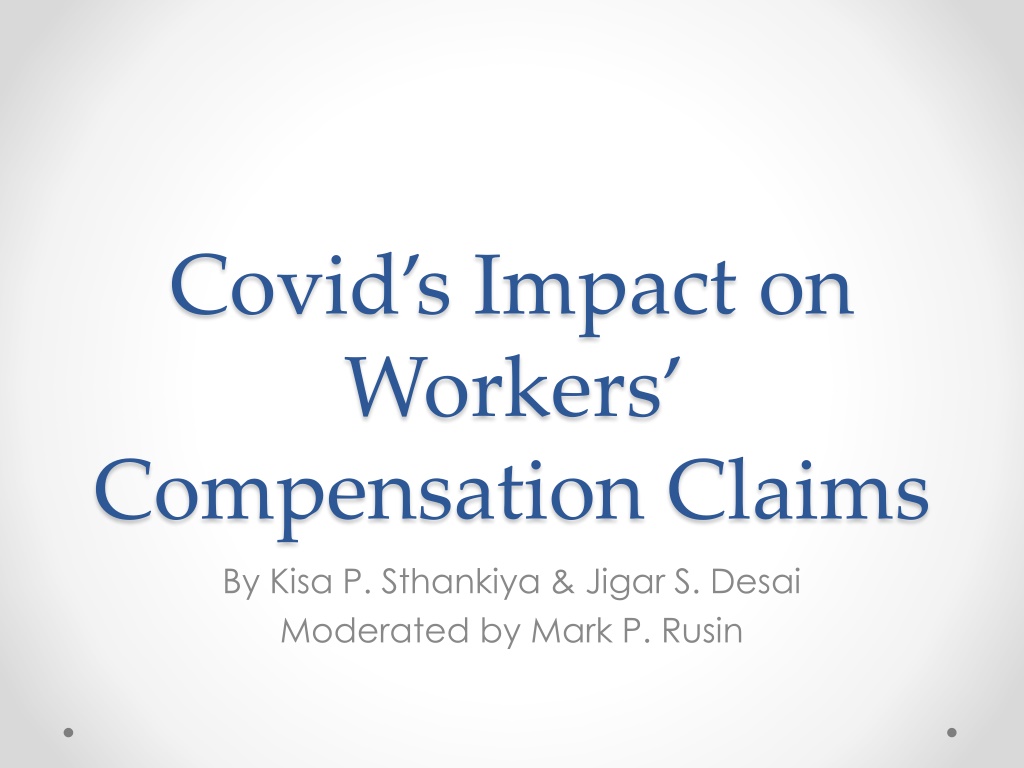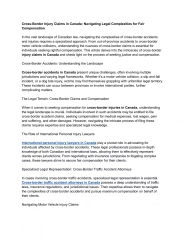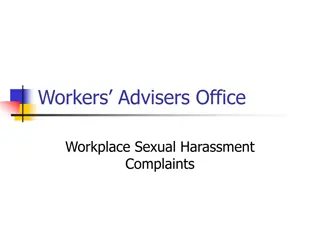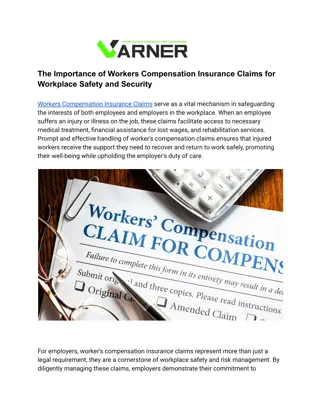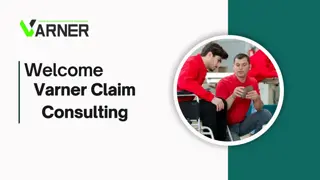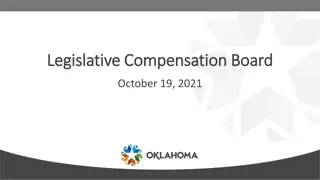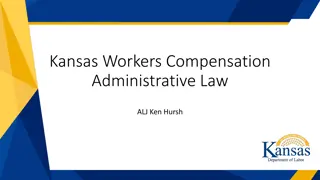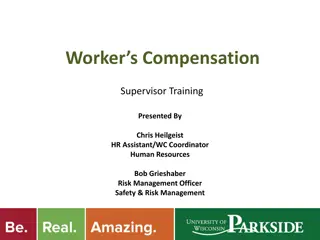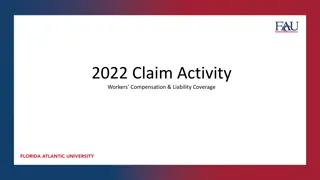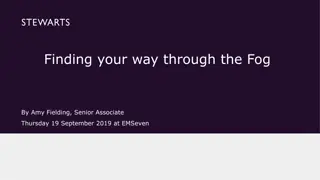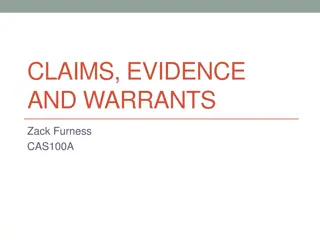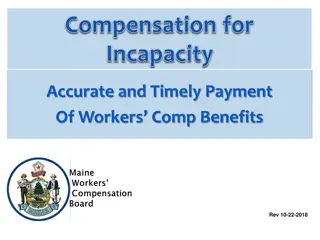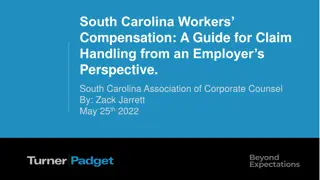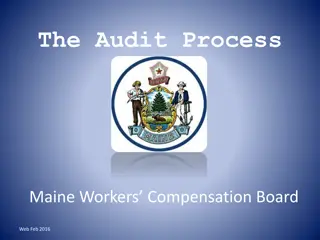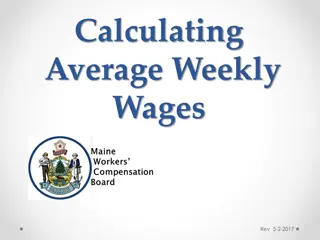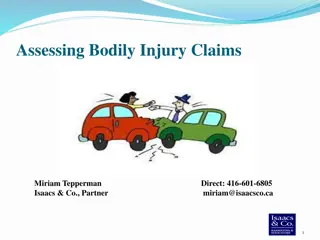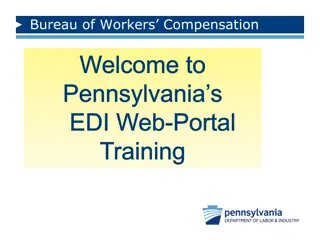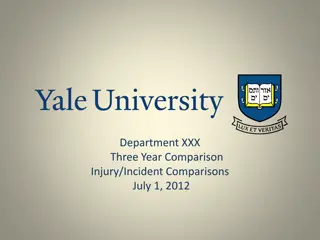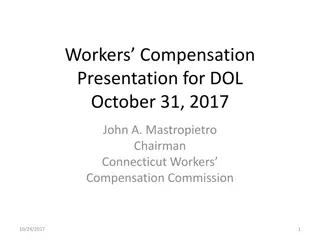Covid's Impact on Workers’ Compensation Claims
The amendment to the Occupational Diseases Act created a rebuttable presumption for certain workers regarding Covid exposure at work. To establish this presumption, claimants must meet specific criteria related to Covid diagnosis dates and frontline worker status. The legislation outlines the process for proving a positive Covid diagnosis and identifies who is covered under this presumption, including first responders, healthcare workers, essential business employees, and frontline workers as defined by executive orders.
Download Presentation

Please find below an Image/Link to download the presentation.
The content on the website is provided AS IS for your information and personal use only. It may not be sold, licensed, or shared on other websites without obtaining consent from the author.If you encounter any issues during the download, it is possible that the publisher has removed the file from their server.
You are allowed to download the files provided on this website for personal or commercial use, subject to the condition that they are used lawfully. All files are the property of their respective owners.
The content on the website is provided AS IS for your information and personal use only. It may not be sold, licensed, or shared on other websites without obtaining consent from the author.
E N D
Presentation Transcript
Covids Impact on Workers Compensation Claims By Kisa P. Sthankiya & Jigar S. Desai Moderated by Mark P. Rusin
REBUTTABLE PRESUMPTION Legislature amended the Occupational Diseases Act and created a rebuttable presumption that Covid exposure occurred at work for certain workers. 820 ILCS 310/1(g) How can a claimant establish that the presumption applies? o Diagnosed Covid infection on or after March 9, 2020 and June 30, 2021 o First responder or front-line worker
Covid Diagnosis In order to establish the presumption applies with respect to a positive Covid diagnosis: o If the diagnosis was made between March 9 and on or before June 15, 2020, an employee must provide a confirmed medical diagnosis by a licensed medical practitioner or positive lab test. The amendment considers that there may not be a clear cut exposure date and defines the accident or onset date as the date the employee was unable to work due to contraction of COVID-19 or was unable to work due to symptoms that were later diagnosed as COVID-19, whichever comes first. o If the diagnosis was made on or after June 16, 2020, the employee must provide proof of a positive laboratory test a medical diagnosis by a licensed medical practitioner is insufficient.
Who is covered? The term COVID-19 first responder or front-line worker includes: o All individuals employed as police, fire personnel, emergency medical technicians or paramedics; o All individuals employed and considered as first responders; o All workers for healthcare providers including nursing homes and rehabilitation facilities and homecare workers; o Corrections officers; and .
Who is covered continued Any individuals who are: o (1) employed by essential businesses and operations AND o (2) are required by their employment to encounter members of the general public OR work in employment locations of more than 15 employees. o Exception - an employee s home or place of residence is not a place of employment except for homecare workers. Front-line workers as defined by Executive Order 2020-10 include workers at the following businesses: o Stores that sell groceries and medicine; o Food, beverage and cannabis production and agriculture; o Organizations that provide charitable and social services; o Media; o Gas stations and businesses needed for transportation; o Financial institutions - including banks, currency exchanges and consumer lenders; o Hardware and supply stores; o Critical trades which include building and construction tradesmen, cleaning and janitorial staff, security and other service providers; o Mail, post, shipping, logistics, delivery and pickup services; o Educational institutions; o Laundry services; o Restaurants for consumption off premises; o Businesses that sell, manufacture or supply products to work from home; o Businesses that sell, manufacture or supply other essential businesses or operations; o Transportation companies o Home-based care and services; o Residential facilities and shelters; o Professional services including law firms, accounting firms and insurance firms; o Daycare centers for employees exempted by the executive order; o Businesses that manufacture, distribute and are supply chain for critical products in industries; o Critical labor union functions; o Hotels and motels; o Funeral services.
Specifically excludes Employees that worked from home exclusively in the 14 days prior to exposure from COVID Employees who are not required to encounter members of the general public or work in employment locations with more than 15 employees
What is a rebuttable presumption? Legal term of art once the claimant has established both elements of the statute (1) positive diagnosis and (2) covered employee under the Act) the burden is on the employer to come forward with evidence to rebut the presumption o Generally, an employee must prove the elements of his/her claim with evidence showing some link to the employment. o Now, an employee need only establish a positive diagnosis and that they are a covered employee to prove a prima facie case that his/her covid exposure and infection was the result of work (even if there were no other known infected workers/staff/members of the general public working at the facility)
Rebutting the Presumption Evidence to establish that the presumption should not apply Employers need only provide some evidence to successfully rebut the statutory presumption Statute outlines 3 ways, at a minimum, the employer can rebut the statutory presumption 1. Employee was working from home for 14 or more consecutive days immediately prior to the injury, disease or period of incapacity from Covid-19 2. Employer provides proof of exposure to Covid-19 by an alternate source
Rebutting the Presumption 3. The employer was engaged in and applied to the best of its ability, industry specific workplace sanitation, social distancing and health and safety practices based on CDC Guidelines. The employer can rebut the presumption by proving that the employee had been protected consistent with the directives of the CDC for at least 14 days prior to the injury, occupational disease or period of incapacity. This would include the requirement of personal protective equipment, sanitation practices, skeleton workforce to promote social distancing Review CDC guidelines to determine if at the date of injury if employer followed them
Rebutted now what? Once the presumption is rebutted or does not apply, Employee can still establish entitlement to benefits under the Occupational Diseases Act o Occupational Disease definition: a disease arising out of and in the course of the employment or which has become aggravated and rendered disabling as a result of the exposure of the employment. Such aggravation shall arise out of a risk peculiar to or increased by the employment and not common to the general public. 820 ILCS 310/1(d) o Arise out of employment: A disease shall be deemed to arise out of the employment if there is apparent to the rational mind, upon consideration of all the circumstances, a causal connection between the conditions under which the work is performed and the occupational disease. 820 ILCS 310/1(d) (emphasis added). An employee shall be conclusively deemed to have been exposed to the hazards of an occupational disease when, for any length of time however short, he or she is employed in an occupation or process in which the hazard of the disease exists. 820 ILCS 310/1(d)
Rebutted now what? o Employee can still establish by a preponderance of the evidence that the Covid-19 exposure was the result of a work-related exposure just as in any infectious disease exposure case. Do not need to prove that there was actual exposure, Nothing in the statutory language requires proof of a direct causal connection. Sperling v. Industrial Comm n, 129 Ill. 2d 416, 421, 544 N.E.2d 290, 292, 135 Ill. Dec. 794 (1989). A causal connection may be based on a medical expert s opinion that an accident could have or might have caused an injury. Consolidation Coal Co. v. Industrial Comm n, 265 Ill. App. 3d 830, 839, 639 N.E.2d 886, 892, 203 Ill. Dec. 327 (1994). In addition, a chain of events suggesting a causal connection may suffice to prove causation even if the etiology of the disease is unknown. Id. o High burden of proof to meet for employee
Vaccines Private employers can require Covid vaccines as a condition of employment o Making a condition of employment opens exposure to liability for adverse reaction to Vaccine Section 11: Any injury to or disease or death of an employee arising from the administration of a vaccine, including without limitation smallpox vaccine, to prepare for, or as a response to, a threatened or potential bioterrorist incident to the employee as part of a voluntary inoculation program in connection with the person s employment or in connection with any governmental program or recommendation for the inoculation of workers in the employee s occupation, geographical area, or other category that includes the employee is deemed to arise out of and in the course of the employment for all purposes under this Act. Lane v. Ferrell Hospital, 97 IIC 832 Hepatitis B vaccine condition of employment for nurse who has adverse reaction found compensable because vaccine was condition of employment not voluntary Employee chooses not to get vaccinated liability? o IL HB 3654 no compensation if unvaccinated employee gets Covid.
Where are we now No exact numbers on how many Covid cases were filed in Illinois to date. o Difficult to assess - significant portion of the health care industry is self-insured, and for the most part, do not report their data to any of the bureaus. The education sector as well as federal, state and local governments are also mostly self-insured, collectively representing over 30 percent of the jobs in the top 20 industries. 90 percent of Sedgwick s COVID claims required little medical treatment or time away from work, while another 8 percent are moderately complex, involving about six weeks away from work and medical visits costing $3,000 to $5,000. In the first three quarters of 2020, workers compensation payments and liabilities were 7.6% lower than in the same period of 2019 Based on a study by Sedgwick of 4,000 patients, 50% were unable to work full-time 6-months post positive test even though only 8% were hospitalized 80% of 50,000 patients studied who were infected with COVID develop one or more long-term symptoms
Covid Claim Comes In SO NOW WHAT? GET TO WORK INVESTIGATING
Confirm the positive test or positive diagnosis and date of same o What was the date of symptom onset in relation to the last date the individual worked? Why does this matter? o The incubation period is generally accepted to be 2-14 days o If the employee last worked on 1/1/2021 and then has symptom onset on 1/21/21 this is outside the incubation period Similarly, if no positive test result until 1/21/21 Was employee working from home or at the place of business? o What is the nature of the work environment? This is where initial investigation is key especially as it relates to the employer s efforts to comply with CDC guidelines and rebut the presumption. o How is the work environment arranged? Are employees required to wear masks both from a policy and practical standpoint? What is the nature of the PPE used. How close are employees over the course of the day and for how long? Are there any photos/schematics of the work environment that can later be used at trial? Are there other employees who have information on how the company was following CDC guidelines both from a practical and policy perspective? Are employees required to be vaccinated? Are employees required to get tested for Covid regularly and/or perform temperature checks before work? Is there any evidence of workplace exposure such as a positive co-worker? If so, what was the nature of the contact between the other worker and claimant? o o o o o o o o What is the nature of the employee s work duties? In addition to the nature of the work environment we must also consider the nature of the employee s actual work duties. o For example, while they may work in a separated environment with other office staff, are they required to interact with members of the general public? o Do they need to be in higher traffic or congregated settings as a result of their work duties? o
Other considerations Are there other possible sources of infection? o If so, how can we find out? Interview the claimant Do they go to the gym? How do they get groceries/other items? o Do they live alone? What is the nature of their living environment house/apartment? o If family members reside with them, try to obtain information as to those family members and their outside activities Attempt to determine whether any family members tested positive at any point Subpoena medical records? Interview co-workers to determine whether they know anything about the employee s outside activities Consider subpoenas for other records: o Cell phone location data has been used with success o Banking/credit card records o Tollway records if the claimant has an iPass o Social media consider reviewing family member social media posts Consider setting an IME with an infectious disease expert to address exposure or an internist to address ability to return to work in advance of considering defense assignment We have seen claimants allege non-specific complaints of anxiety to treating primary care doctors and be continued off work despite a negative covid test (after testing positive) this just allows for higher TTD exposure We recommend aggressively addressing and disputing any work restrictions from a primary care provider for non-specific complaints o
Benefits for claimants With any Covid claim there will likely be a minimum requirement of a 14-day quarantine by any employer. There is TTD exposure for this period of time. o The amendment slightly modifies the eligibility requirements for TTD. In order for an employee to qualify for TTD benefits, the employee must be certified or recertified for temporary total disability benefits. Though certified or recertified are not defined, it is likely the terms refer to a work status slip from a doctor. Medical bills the vast majority of cases involve relatively mild cases with limited medical expenses.
Benefits Serious cases: o Longer TTD exposure period depending on condition of claimant o Greater medical bill exposure o Greater PPD exposure o Death benefit exposure: TTD to date of death; Medical bills incurred to date of death; Burial expenses; Death benefits consideration of dependents and marital status
PPD Exposure Assessing permanent partial disability: Opinions are mixed unsurprisingly between the Petitioner s and Defense bars No reported decisions assessing PPD for mild or severe cases As of this week, not a single Covid case has even been tried before an Arbitrator But pre-trials have been conducted with favorable results especially where the employer can rebut the presumption many Arbitrator s are skeptical of finding exposure where there is no direct proof and the employer complied with CDC guidelines o For mild cases with full recovery: o Petitioner s bar : 1-3% MAW Not cheap depending on the earnings of the employee. When considering public employees, with maximum PPD rates, each 1% MAW equates to: $4,355.65 o Defense bar: No PPD for mild cases with full recovery and limited medical treatment
Covid Sequelae Unlike other infectious diseases, Covid s long-term impacts are unknown o Initially, the thinking was that cases are either mild/symptom free or result in intubation and death o Today, we know more, but still haven t figured out what to call it: Long Covid, chronic Covid syndrome, long haul Covid, and PASC or post-acute sequelae of SARS- CoV-2 infection Patients are alleging: anxiety, fatigue, a racing heartbeat, shortness of breath, achy joints, foggy thinking, a persistent loss of sense of smell and damage to the heart, lungs, kidneys These subjective complaints such as fatigue or foggy thinking could result in a higher PPD evaluation by an Arbitrator o Vitally important we try to rebut these subjective complaints How? o Investigate personal life/social media are they engaging in activities they say they can t to their doctors o Confer with co-workers o Consider surveillance Want to provide our IME with as much information/evidence as possible as the employee is alleging non-specific objectively difficult to verify complaints IME doctors may give the benefit of the doubt in the absence of other evidence o While long COVID is observed after COVID-19 infection, it has not been reported after COVID-19 vaccination, with over 100,000 participants included in vaccine trials as of December 2020.
What we are seeing Favorable pre-trials on the exposure issue when we can rebut the CDC presumption and there is no direct proof of exposure Mild cases with apparent full recovery o Minimal lost time generally 14 days o Minor medical bills cost of the test o PPD essentially primary issue in dispute given relatively minor Covid case/symptoms with a return back to full duty work Fewer severe or death claims Long Covid claims with non-specific complaints of fatigue/anxiety/stress/lost of taste/brain fog
Thank You Kisa Sthankiya ksthankiya@rusinlaw.com 312-454-5127 Jigar Desai jdesai@rusinlaw.com 312-454-5132
